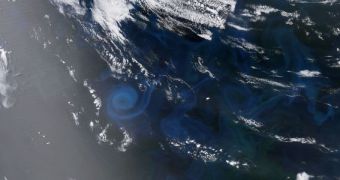Phytoplankton are tiny organisms living near the surface of oceans. They represent the basis of the marine food chain, and are indispensable to the diets of larger species. To compensate for the fact that they are always being eaten, phytoplankton bloom in very large numbers when conditions are right.
The image above, captured by the Moderate Resolution Imaging Spectroradiometer (MODIS) instrument on the NASA Aqua satellite reveals just how large such blooms can be. The photo is centered on the southeastern Indian Ocean, around 600 kilometers (373 miles) away from Australia.
According to experts, the bloom has been captured by an ocean eddy, which explains its spiral-like appearance. The same current may have also concentrated a lot of nutrients at this particular location in the ocean, which might in turn explain how so many phytoplankton developed in a single spot.
Phytoplankton require nutrients, water and sunlight to grow. The eddy supplies the nutrients, while ample sunlight is available due to the fact that it is now summer in the southern hemisphere. These factors can sometimes combine to create massive blooms at various locations around the world.

 14 DAY TRIAL //
14 DAY TRIAL //